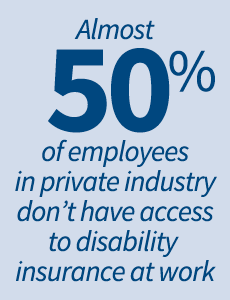You may already have it.
According to the Bureau of Labor Statistics, at least half of U.S. non-government employees have disability insurance.1 If your company doesn’t offer disability insurance, there are various ways you can set up your own coverage.
Here are steps you can take to find the best plan:
 Talk to your employer about disability insurance.
Talk to your employer about disability insurance.
Meet with your HR department and ask whether they offer disability insurance. Here are some initial questions to ask:
- If they offer disability insurance, is it employer-paid, employee-paid, or a combination of the two? The general rule is, if your employer pays some or all of the premium, then some or all of any benefits you collect will be taxable to you. Your employer may offer a voluntary plan where you will need to pay the entire premium. However, it grants you access to better rates — and any benefits you collect will not be taxed. Ask how much it costs and how you can sign up for it.
- What is the benefit amount for the policy? It won’t be your full salary, as your employer wants some incentive for you to return to the job. Policies generally range from 40 to 70 percent of your salary.
- How long will my payments last? A policy will indicate the maximum length of time that benefits will last. Long-term disability insurance may cover anywhere between two years through retirement age.
- When will payments begin? This will depend on whether it’s short-term or long-term disability insurance. Both types of coverage include waiting periods. A waiting period is the time between when you leave work to have your baby or you are diagnosed with a condition that prevents you from working, and when payments begin.
- What is the policy’s definition of disability? The definition of disability varies among policies and carriers. Some consider it related to you not being able to perform the duties of your specific job while others take into account your training and experience. You may carry a policy that pays you if you can’t perform your “own job,” “own occupation,” or “any occupation” that reasonably matches your knowledge, training and experience.
- If you don’t have access to disability insurance at work: Ask why not. You could ask whether they would consider a starting a voluntary policy for employees.
Talk to your financial advisor about disability insurance.
If you aren’t currently offered disability insurance at work, or the amount they are offering won’t cover your basic living costs, consider purchasing individual insurance. Your financial advisor or insurance agent will be able to help you identify the amount you need, the most suitable amount of time you’d want to receive payments, and which plan makes the most sense for your unique needs.
Talk to our member companies about disability insurance.
The member companies of The Council for Disability Awareness (CDA) formed this nonprofit organization solely to educate consumers, employers, and financial advisors about working adults’ risk to be out of work for a period of time without a paycheck. We appreciate their commitment to this effort. View the member organizations here.
- Bureau of Labor Statistics, Unpublished estimates, National Compensation Survey, “Access to disability benefit combinations, by occupation group, private industry workers, March 2017”.

“How much protection do I need?”
Start by assessing your income and expenses. How much cash would you need to cover your basic daily living costs like the mortgage, groceries, car payments, student loan debts, and so on? Most people are advised to cover 60 percent of their normal income. Next, how long you could go without a paycheck? Do you have enough savings to cover you for three months? Understanding your financial life is the first step to protecting it.


